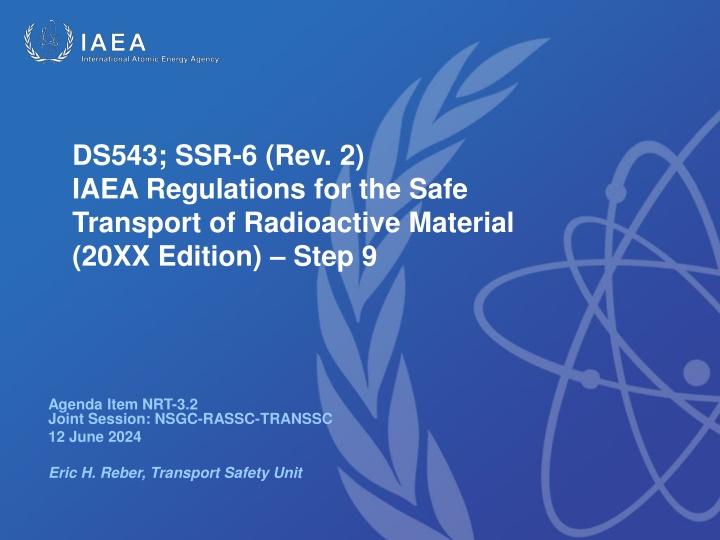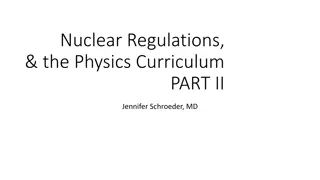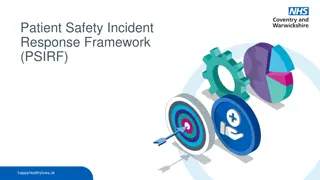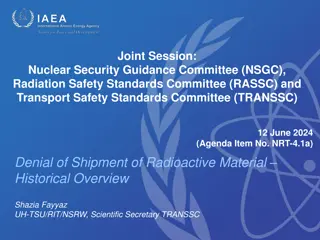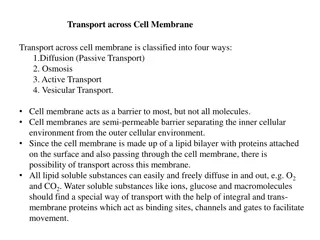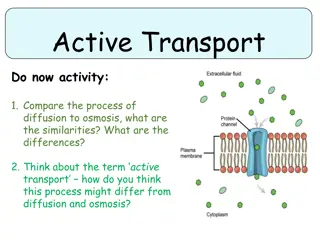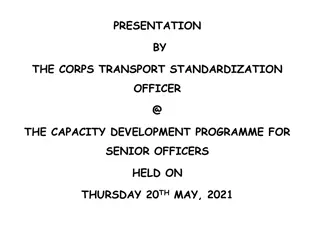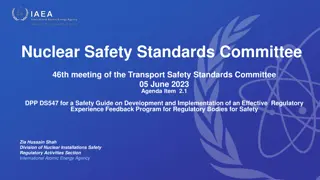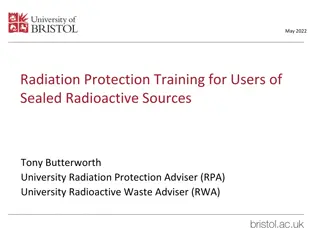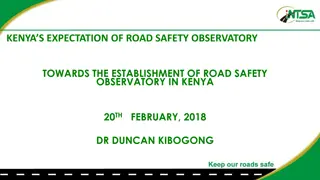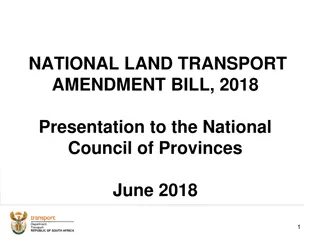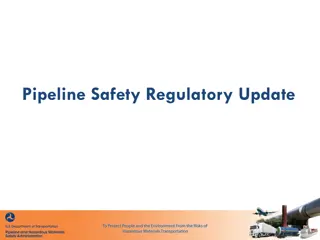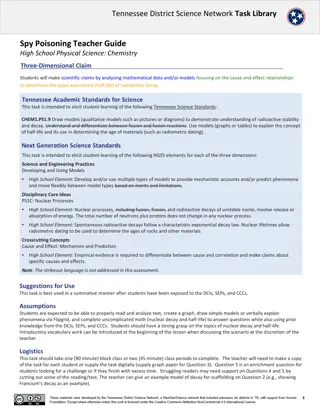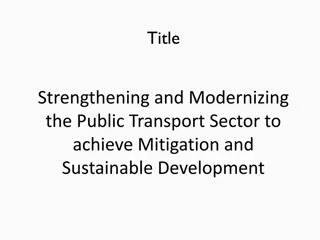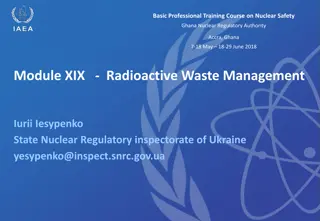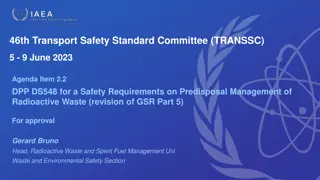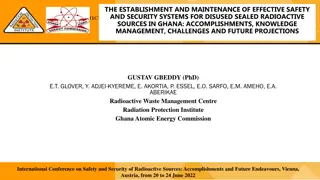International Regulatory Framework for Radioactive Material Transport Safety
SSR-6 (Rev.1) establishes safety requirements for transporting radioactive material to protect people and the environment from ionizing radiation. The framework applies globally across land, water, and air transport modes, involving operations and conditions related to radioactive material movement.
Download Presentation

Please find below an Image/Link to download the presentation.
The content on the website is provided AS IS for your information and personal use only. It may not be sold, licensed, or shared on other websites without obtaining consent from the author.If you encounter any issues during the download, it is possible that the publisher has removed the file from their server.
You are allowed to download the files provided on this website for personal or commercial use, subject to the condition that they are used lawfully. All files are the property of their respective owners.
The content on the website is provided AS IS for your information and personal use only. It may not be sold, licensed, or shared on other websites without obtaining consent from the author.
E N D
Presentation Transcript
DS543; SSR-6 (Rev. 2) IAEA Regulations for the Safe Transport of Radioactive Material (20XX Edition) Step 9 Agenda Item NRT-3.2 Joint Session: NSGC-RASSC-TRANSSC 12 June 2024 Eric H. Reber, Transport Safety Unit
Presentation Overview Objective and Scope of SSR-6 International regulatory framework for transport safety Review/Revision Policy Review Cycle Revision Cycle (SPESS) Step 8: Soliciting comments by Member States Step 9: Addressing comments by Member States Comments on the impact of proposed revision of A1/A2values DPP for a TECDOC on the Q System and A1/A2values
Objective and Scope of SSR-6 The objective of SSR-6 (Rev. 1) is to establish requirements that must be satisfied to ensure safety and to protect people, property and the environment from harmful effects of ionizing radiation during the transport of radioactive material. SSR-6 (Rev. 1) applies to the transport of radioactive material by all modes on land, water, or in the air. Transport comprises all operations and conditions associated with, and involved in, the movement of radioactive material.
International Regulatory Framework for Transport Safety 193 signatories Incorporation of SSR-6 into the Model and Modal Regulations Model regulations for all dangerous goods 192 signatories Class 7 All modes Air Mail 167 signatories Sea Land transport Road, Rail and Inland Waterway Regional: MERCOSUR/MERCOSUL (4) ADR (54), RID (51), ADN (17) 4
Policy for reviewing and revising the Agencys Transport Regulations [Board of Governors (GOV/2005/31)] Transport regulations reviewed every two years the decision on the revision and publication will be made based on the assessment of TRANSSC/CSS If TRANSSC considers that a proposal for change stemming from a review cycle is sufficiently important for safety to necessitate publication as soon as possible, the Secretariat will initiate the revision process
Graphical Overview of the Review Process Proposals for change received by the Secretariat Initial review of proposals for change by TTEGs Recommendations by TTEGs to TRANSSC: accepted rejected impact on safety comments Recommendation / Decisions process for each individual proposal for change using the secondary set of questions in Annex 1 TRANSSC decisions: accepted rejected impact on safety Decision based on whether the aggregate of the accepted proposals would amount to a change in requirements that is important in terms of safety using the primary set of questions in Annex 1 TRANSSC decision on whether to revise SSR-6 (Rev. 1)
Overview of Proposals for Change 306 proposals received from Australia(3), Belarus(5), Belgium(1), Canada(10), France(70), Germany(11), IATA(12), ISO(3), Italy(7), Japan(17), Morocco(7), Oman(3), Pakistan(2), Russia(11), Sweden(15), Switzerland(28), WNTI(79), TIC(5), UK(8), USA(6) 294 unique proposals were assigned to primary TTEGs: TTEG Primary TTEG-C TTEG-OM TTEG-PPA TTEG-RP 37 177 62 18
Decision at TRANSSC 45 to enter a Revision Cycle Based on the presentations and understanding of the TTEG recommendations to TRANSSC for each change proposal, coupled with the outcomes from the moderated discussions, roughly 75 change proposals were identified that would be addressed/acted on during the revision process. In summary, there was nearly unanimous support from the Member States to move into the revision of SSR-6 (Rev. 1).
Activity Start End 18 August 2022 STEP 1: Preparation of DPP July 2022 STEP 2: Internal review of the DPP (Approval by the Coordination Committee) 11 August 2022 18 August 2022 STEP 3: Review of the DPP by the Review Committees 26 August 2022 2 December 2022 STEP 4: Review of the DPP by the CSS (approval by CSS) 23 March 2023 23 May 2023 Revision Cycle Overview STEP 5: Development of revised manuscript of SSR-6 (Rev. 2) December 2022 24 July 2023 STEP 5*: Development of modified text for proposals that were designated as Accepted, but modified during T-45 December 2022 20 April 2023 STEP 5**: Review of revised text at TRANSSC 46 5 June 2023 9 June 2023 STEP 6: First internal review of SSR-6 (Rev. 2) (Approval by the Coordination Committee) 24 July 2023 24 August 2023 STEP 7: First approval of the draft publication by the Review Committees 31 August 2023 December 2023 STEP 8: Soliciting comments by Member States December 2023 May 2024 STEP 9: Addressing comments by Member States April 2024 July 2024 STEP 10: Second internal review of the draft publication (Approval by the Coordination Committee) July 2024 August 2024 STEP 11: Second review of the draft publication by the review Committee(s) (Approval of the draft) STEP 12: Editing of draft in MTCD and endorsement of the draft by the CSS, establishment by the Publications Committee and editing September 2024 November 2024 December 2024 April 2025 STEP 12*: Silence approval of the final edited text by TRANSSC STEP 13: Approval by the Board of Governors STEP 13*: Submittal of SSR-6 (Rev. 2) to UNECE STEP 14: Publication May 2025 June 2025 October 2025 October 2025 May 2025 September 2025 March 2026 January 2026
Step 8: Soliciting comments by Member States Note Verbale that solicited comments was issued on 3 January 2024 with a deadline of 8 May 2024 Review Cycle for SSR-6 (Rev. 1) was initiated with a NV that was issued on 5 November 2021 In accordance with the 2021 Transport Regulations Revision Quality Plan, only proposals that were submitted before the deadline of 18 March 2022 in response to the 5 November 2021 NV would be considered in the Revision Cycle. Table 2 of the draft SSR-6 (Rev. 2) included changes to approximately 64% of the A1 values and 45% of the A2 values that are based on the results of the work of the TRANSSC s A1/A2 WG. Joint TRANSSC/RASSC WG formed to consider (1) the details of the calculation methods of the A1/A2 Working Group, (2) the justification for the proposed changes to the A1 and A2 values, and (3) the potential impact of revised A1 and A2 values on other IAEA safety standards Comments were requested: Relevance and usefulness; scope and completeness, quality and clarity Revised A1/A2 values - Do you have any specific comments in relation to the justification for, or impact of, the proposed revised values? 285 Official comments received from Argentina (1), Australia (12), Belgium (3), Canada (13), Finland (1), France (62), Germany (54), Israel (3), Jamaica (5), Japan (33), Oman (9), Pakistan (16), Russia (9), Sweden (3), United Kingdom (19), United States (7), Switzerland (7), ISO (3), ISSPA (2), WNTI (23)
Step 9: Addressing comments by Member States Draft resolution table and revised draft SSR-6 (Rev. 2) were developed during a consultancy meeting on 20 24 May 2024. Both files were uploaded to the RASSC/TRANSSC folders for information . TRANSSC-48: Recommendation to reject a comment or text to be included in DS543 requested from TTEG-C on RUS-5, and from TTEG- RP on A1/A2/Table 2 issues, i.e. ARG-1, JPN-03, AUS-1, CDN-04, GER- 8, FR-23, WNTI-02, USA-2 and UK-3.
Step 8 Comments on the impact of the proposed revised A1/A2 values Radionuclide(s) Issue Th-228 Reduction of 10% in the A2 value for Th-228 (1 GBq to 0.9 GBq) is likely to have a significant impact on the operational planning for organizations that are using Th-228 to produce Pb-212 for medical applications. Such a change in A2 may increase cost with no corresponding improvement in practical safety. It is recommended to retain the current A2 values for Th-228. Comment AUS-1 & AUS-3 AUS-2 A2 value is proposed to be reduced from 0.2 TBq to 0.0009 TBq, a significant reduction in the amount of radioactive material that can be transport in a Type A package. Pb-212 based radiotherapies are being developed; therefore, the delivery of critical medical supplies may be hindered. Pb-212 CDN-04 Several of the RN that are listed are being used in the development of new radiopharmaceutical therapies. Type B packages may need to be developed to transport these radionuclides, which will present challenges to handling this material in a cost-effective way. Patient access to these RN may be adversely impacted. The inclusion of alpha particles in QD,skin is overly conservative. A2 values are proposed based on the most restrictive of the revised QC, QD,inh or current QD,skin values
Schedule for the rest of 2024 Step 10 Second internal review of the draft publication 4 July - DS543 submitted to standards specialists (i.e. technical editors) for comprehensive textual review August Approval by the Coordination Committee Step 11 Second review of the draft publication by the Review Committees No later than 29 August resolution table and DS543 uploaded for consideration by Review Committees 8 October comments due on the resolution of the official comments 22 October resolution table and revised DS543 posted 29 October 13 December: meetings of the Review Committees TRANSSC: 18 22 November NSGC: 3 6 December RASSC: 9 13 December
TECDOC Q System & A1/A2 values Proposed Title: Determination of quantities of radioactive material that represent equivalent radiological consequences for use in IAEA Regulations for the Safe Transport of Radioactive Material - the Q System for the Calculation and Application of A1 and A2 Values Background Q system defines the quantity limits, in terms of the A1 and A2 values, of a radionuclide that is allowed in a Type A package. These limits are also used for several other purposes in SSR-6 (Rev. 1). App. I of SSG-26 (Rev. 1) provides a description of the Q system including its parameters and the method for deriving A1 and A2 values. Beginning in approx. 2014, TRANSSC s A1/A2 Working Group conducted a review of the Q system calculations on which the A1 and A2 values in Table 2 of SSR-6 (Rev. 1) are based, and ultimately recommended revised values that take account of current dose coefficients and modelling techniques, as well as updated radiological data.
TECDOC Q System & A1/A2 values Justification As decided at TRANSSC-46 in June 2023 and recorded in the DPP for the revision of SSG 26 (Rev. 1) (DS554), historical and safety basis information such as that in Appendix I of SSG-26 (Rev. 1) that is not appropriate content in safety standards should be removed and placed in another document, such as the proposed TECDOC. Regarding the work of the A1/A2 WG, this work represents an exhaustive review of the Q system. Furthermore, some of the A1 and A2 values derived by this working group differ in important ways from the corresponding values in Table 2 of SSR-6 (Rev. 1). Because of the significant impact that such work could have on SSR-6 (Rev. 1) and the possible relevance of these calculation methods to other safety standards, it is necessary to publish information related to the details of the work performed by this group. The publication of such information is in line with the Agency s long- standing policy of publishing the results of such significant research, e.g. publishing the results of Coordinated Research Projects.
TECDOC Q System & A1/A2 values Objective to provide a description of the update of the Q system including its parameters and the method for deriving A1 and A2 values that takes account of the work of the A1/A2 Working Group it is expected that this information will be useful for competent authorities, individuals and organizations involved with the transport of radioactive material, and radiation protection specialists that are concerned with transport issues Scope the Q system including its parameters and the method for deriving A1 and A2 values both the historical Q system and the activities of the A1/A2 Working Group including its working methods and results it will not include analysis of the consequences of the update of the A1 and A2 values on the transport industry
TECDOC Q System & A1/A2 values Place in the overall structure of the relevant series and interfaces with existing and/or planned publications The proposed TECDOC is an informational publication and therefore not part of the IAEA Safety Standards Series. [Therefore, not subject to the 14 Steps of SPESS] Historical and safety basis information concerning the Q System in SSG- 26 (Rev. 1), i.e. information that is not appropriate content in safety standards, will be removed from that document and placed in the proposed publication. The A1 and A2 values that were derived by the A1/A2 Working Group may be incorporated into a future revision of SSR-6 (Rev. 1). Furthermore, the calculation methods and dose coefficients that were used by the A1/A2 Working Group may establish a precedent that would affect the way similar calculations are performed in the context of publications other than SSR-6 (Rev. 1) within the IAEA Safety Standards Series, e.g. GSR Part 3.
TECDOC Q System & A1/A2 values Overview of the contents The intention is to include with this publication or to make available in some other way, the software and associated data files necessary for the derivation of A1/A2 values according to the methods used by the A1/A2 WG. NB: Initial information gathering within the Agency indicates that it will be possible to make the relevant software and data files available to Member States and other stakeholders; however, as of 3 June 2024, associated legal and technical issues remain to be addressed. The proposed structure of the document is based on a combination of Appendix I of SSG-26 and the Report of the WG A1/A2 for the 2021-2024 SSR-6 review and revision cycles, Version 1.1
TECDOC Q System & A1/A2 values Outline 1. INTRODUCTION Background Objective Scope Structure 2. BASIS OF THE Q SYSTEM Principles Use of the Q System in the regulations Analysis of historical Q System 3. DOSIMETRIC MODELS AND ASSUMPTIONS External dose due to photons and beta emitters Derivation of the historical Q System Update proposed by the A1/A2 Working Group Internal dose via inhalation Derivation of the historical Q System Update proposed by the A1/A2 Working Group Skin contamination and ingestion doses Derivation of the historical Q System Update proposed by the A1/A2 Working Group Submersion dose due to gaseous isotopes Derivation of the historical Q System Update proposed by the A1/A2 Working Group (Including an overview of the activities of the A1/A2 Working Group)
TECDOC Q System & A1/A2 values Outline (con t) 4. SPECIAL CONSIDERATIONS Consideration of parent and progeny radionuclides Basis of the historical Q system Update proposed by the A1/A2 Working Group Alpha emitters Neutron emitters Bremsstrahlung Krypton 85 Tritium and its compounds Radon and its progeny 5. UNLIMITED VALUES Basis of the historic Q System Update proposed by the A1/A2 Working Group Enriched uranium
TECDOC Q System & A1/A2 values Outline (con t) 6. APPLICATIONS Release rates for normal transport Release rates for accident conditions 7. MULTI-PATH CUMULATIVE DOSE 8. TABULATION OF Q VALUES Consideration of physical and chemical properties Multiple exposure pathways Mixtures of radionuclides 9. DECAY CHAINS USED IN THE Q SYSTEM 10. VALIDATION PROCESS Quality assurance 11. Q Values and A1 and A2 VALUES DERIVED BY THE A1/A2 WORKING GROUP (This section will include radionuclides that are listed in Table 2 of SSR-6 and those that are not.)
TECDOC Q System & A1/A2 values Status/Path Forward Input from the Joint TRANSSC/RASSC WG has been incorporated into the DPP. Draft DPP has been uploaded to the TRANSSC and RASSC folders for the current meetings Internal approval by the Coordination Committee is needed Target publication date: December 2025
